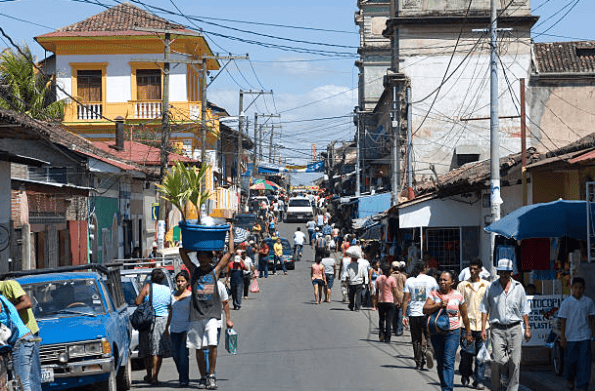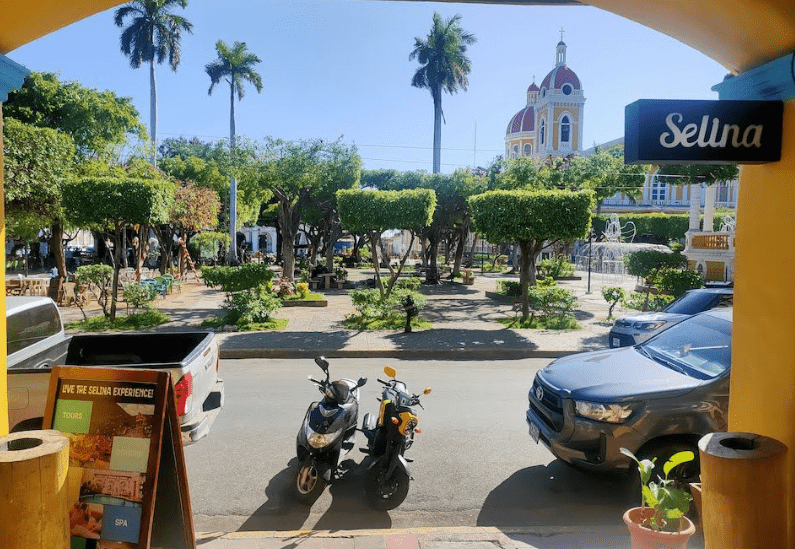The name Nicaragua may not be very familiar to most Indonesians, which is understandable since it’s not a well-known tourist destination. Currently, I’m traveling in Nicaragua because I’m continuing my studies in neighboring Costa Rica. Follow my Central American adventure in this post.

It all started on a KLM flight from Amsterdam to San José (the capital of Costa Rica), when I spontaneously purchased unlimited WiFi for 16 euros to search for New Year’s Eve 2023 destinations. My husband and I purposely booked our tickets for December 30th so we could ring in the New Year on a new continent. After some googling in the air, we decided to celebrate the New Year in Costa Rica and then head to Nicaragua (its neighboring country) after the countdown.
I don’t have a Costa Rican visa, but with a US B1/B2 visitor visa, Indonesian passport holders can visit several Central American countries without needing a visitor visa, such as Mexico, Panama, Guatemala, El Salvador, Belize, and Honduras. Nicaragua is the only Central American country where Indonesians can enter without a visa, simply by paying a tourist entry fee.

At the border, you may be asked how long you plan to stay in Nicaragua and whether you have an onward ticket. If you’re unsure when you’ll leave or which country you’ll go to next, they might inquire further.
My husband and I chose to travel to Nicaragua by night bus, as it’s cheaper than flying. The journey to Managua (the capital of Nicaragua) takes around 12 hours. If traveling by car, the trip would be shorter, but border checks prolong the bus journey from San José to Nicaragua.
We booked tickets on Ticabus (another option is Nicabus). The price is roughly the same, around $32 one-way. The bus departs at 2 AM (yes, very early in the morning!) from San José. Because of the odd departure time, I took a nap at home beforehand since I knew I wouldn’t easily sleep on the bus. Another option is a 7 AM bus that arrives at 7 PM, but I didn’t want to waste productive hours on the road.

At 12:15 AM, my campus friend (who I managed to convince to join the trip) picked me up in front of my house. We arrived at the Ticabus terminal at 12:30 AM and waited in the passenger lounge for the boarding process. Half an hour before departure, we were allowed to board by showing our passports and tickets. The staff also reminded us about the $8 exit fee from Costa Rica, which can be paid online or in cash at the border. It was my first time experiencing a country charging an exit fee.
I was prepared with a jacket and socks, as I had read reviews warning that the bus AC would be very cold, and indeed it was! I also brought a sleep mask to at least try to catch some sleep.

The bus stopped only once at 4:30 AM at a 24-hour restaurant in northern Costa Rica. I tried rice and red beans with shredded chicken soup, a typical Latin dish, but found it rather bland (unlike Indonesian food, which is rich in spices).
The journey across the border passed through areas with lush forests and lots of greenery. We reached the Peñas Blancas border at around 8:30 AM. Exiting Costa Rica was quick, but entering Nicaragua took longer due to baggage checks, random screenings, queues, COVID checks, and passport interviews. The entire process took about 2.5 hours. The fees we paid totaled $14:
- $10 for tourist entry
- $3 for immigration
- $1 for the municipal tax
It’s a good idea to bring cash for these payments. On the bus, there were also women offering currency exchange services cambio to swap US dollars or Costa Rican colones for Nicaraguan córdobas. We decided to exchange a small amount, just in case we needed it at the border.
Once in Nicaragua, I honestly felt like I was in rural Indonesia. The scenery was filled with tropical plants, shaded roads, simple wooden and brick houses, and unfortunately, some litter by the roadside.
The main city we visited was Granada, which is full of beautiful colonial Spanish-style buildings and sits right on the shore of Lake Nicaragua. This small city was founded in the 16th century and is home to many historic, colorful buildings. The Central American atmosphere was palpable, and at night, the bars played Caribbean and Latin American music.

We arrived in Granada at noon. Being further south, it’s closer than Managua. We walked about 10 minutes from the bus stop to our accommodation, Selina Granada, a chain of hotel/coworking spaces across Latin America. The vacation vibe hit us immediately, with colorful houses, oversized doors, and hipster cafes and restaurants.

Stay tuned for more about our 5-day adventure in Nicaragua in my next blog! For now, I can say that traveling in Nicaragua isn’t very expensive, as the country’s economy isn’t as developed as its neighbors.

The Benefits of Umary Supplements for Overall Health and
Well-being
# The Benefits of Umary Supplement for Overall Health and Well-being
## What is Umary Supplement?
Umary supplement is a comprehensive health
product designed to support overall well-being through a combination of essential nutrients.
It typically includes key ingredients such
as vitamin D, omega-3 fatty acids, and other vitamins/minerals that are crucial for maintaining optimal body function. The formula
is carefully crafted to ensure that users receive a balanced
blend of nutrients that work synergistically to promote health.
## The Benefits of Umary Supplement
The Umary supplement has been formulated with specific benefits in mind, catering to various aspects of health and wellness.
### Boosting Your Immune System
Your immune system plays a vital role in protecting your body from pathogens.
A strong immune system is essential for maintaining overall health.
Ingredients like vitamin C and zinc in Umary help fortify the immune system, reducing the risk of infections and
supporting overall defense mechanisms.
### Increasing Energy Levels
Energy levels are crucial for daily activities. Umary
contains ingredients like B vitamins and caffeine (if present) that can enhance energy production, helping you stay active throughout the day.
This energy boost is natural and can help in maintaining a healthy
lifestyle without relying on stimulants.
### Supporting Various Bodily Functions
Umary supplement aids in supporting numerous bodily
functions essential for health:
– **Digestive Health**: Ingredients may support gut function and promote optimal
digestion.
– **Joint Function**: Nutrients like omega-3s and calcium help maintain joint health and reduce inflammation.
– **Heart Health**: Omega-3s contribute to heart
health by reducing triglycerides and supporting
cardiovascular function.
## Frequently Asked Questions
**1. Is Umary supplement safe?**
Umary is designed with safety in mind, using ingredients that are generally recognized
as safe. However, consult a healthcare professional before starting any
new supplement to ensure it suits your health needs.
**2. Are there any side effects?**
As with any supplement, potential mild side effects may occur,
such as gastrointestinal discomfort. These are
usually temporary and subside with continued
use.
**3. How does Umary differ from other supplements?**
Umary combines a unique blend of nutrients tailored
to support overall health, distinguishing it from other products that
may focus on specific areas like weight loss or muscle building.
**4. Can I take Umary on an empty stomach?**
It’s generally safe to take Umary with or without food.
For optimal absorption, consider taking it with meals to aid nutrient uptake.
## Conclusion
Umary supplement offers a holistic approach to health by supporting immune
function, energy levels, and bodily functions. Its blend of nutrients makes it a valuable addition to a healthy lifestyle.
Consider incorporating Umary into your daily routine to enhance your overall well-being.
—
**Sources:**
– Umary Supplement official website
– Nutritional guides and research articles on ingredient benefits
Also visit my website oral steroids list; Marilou,
70918248
References:
what are products That are consumed rapidly and regularly classified as? (https://pinocchiosbarandgrill.com/menus/big-ass-salad/img_1743/)
Hola! I’ve been following your website for a while now and finally
got the courage to go ahead and give you a shout out from Atascocita Texas!
Just wanted to say keep up the fantastic work!